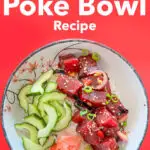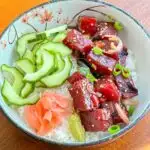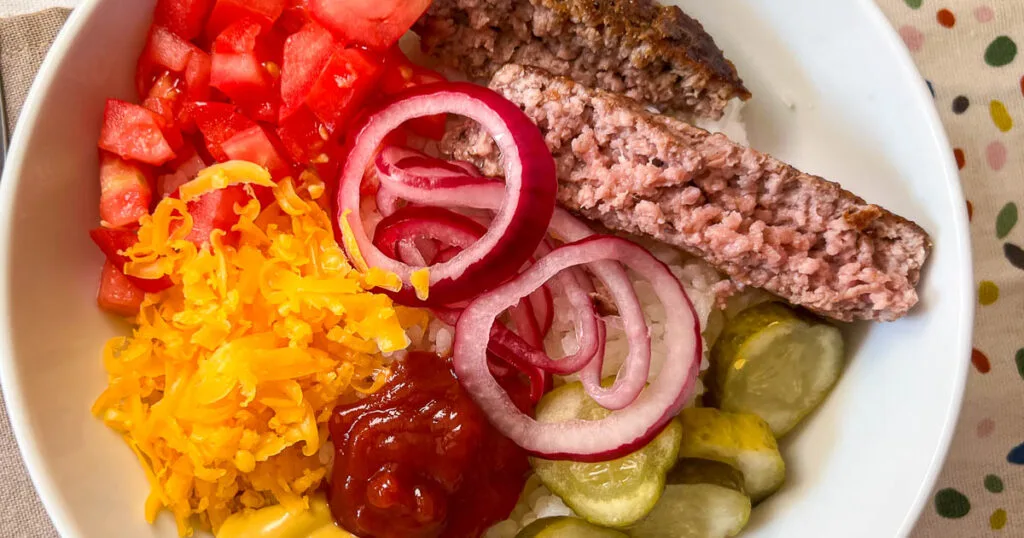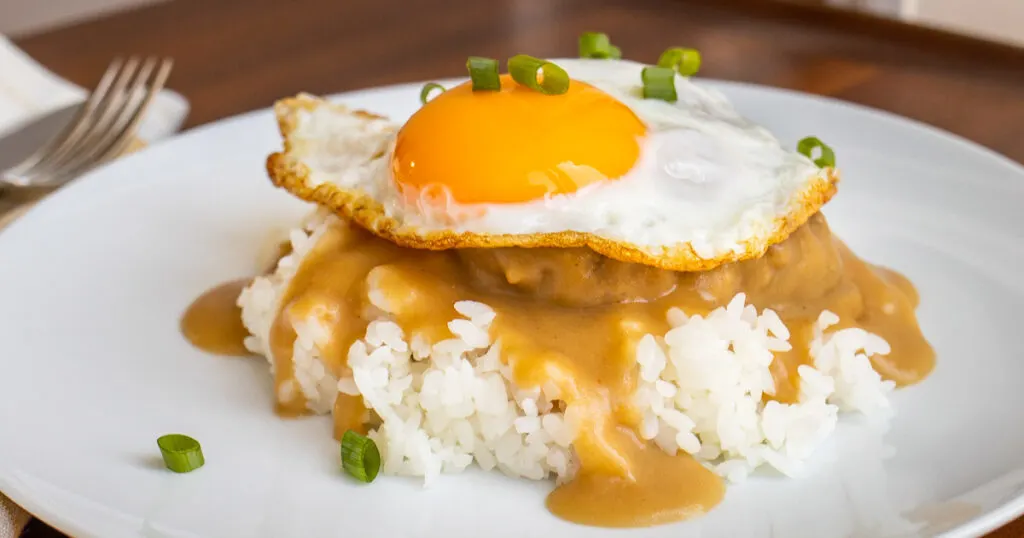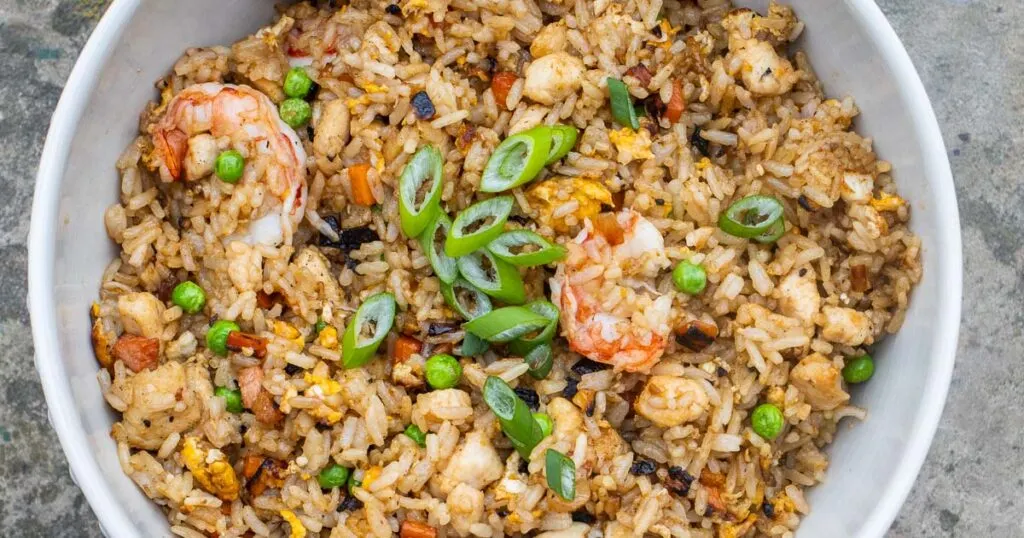Attention tuna lovers! Our Tuna Poke Bowl Recipe is one of the best dishes you can make in your home kitchen. With some quality tuna and the right ingredients, you’ll quickly go from poke zero to poke hero.

Who doesn’t love raw tuna?
Judging by the prices that sushi restaurants charge, this is clearly a rhetorical question. And, while people been eating raw tuna in nigiri and sashimi for decades, ahi tuna poke has taken center stage in recent years.
We ate our first tuna poke bowl in Las Vegas, the city cheekily referred to as Hawaii’s ninth island, nearly a decade ago. It only took one bowl for us to discover the joy and satisfaction of munching into savory chunks of raw tuna swimming in a soy marinade flavored with seaweed and sesame.
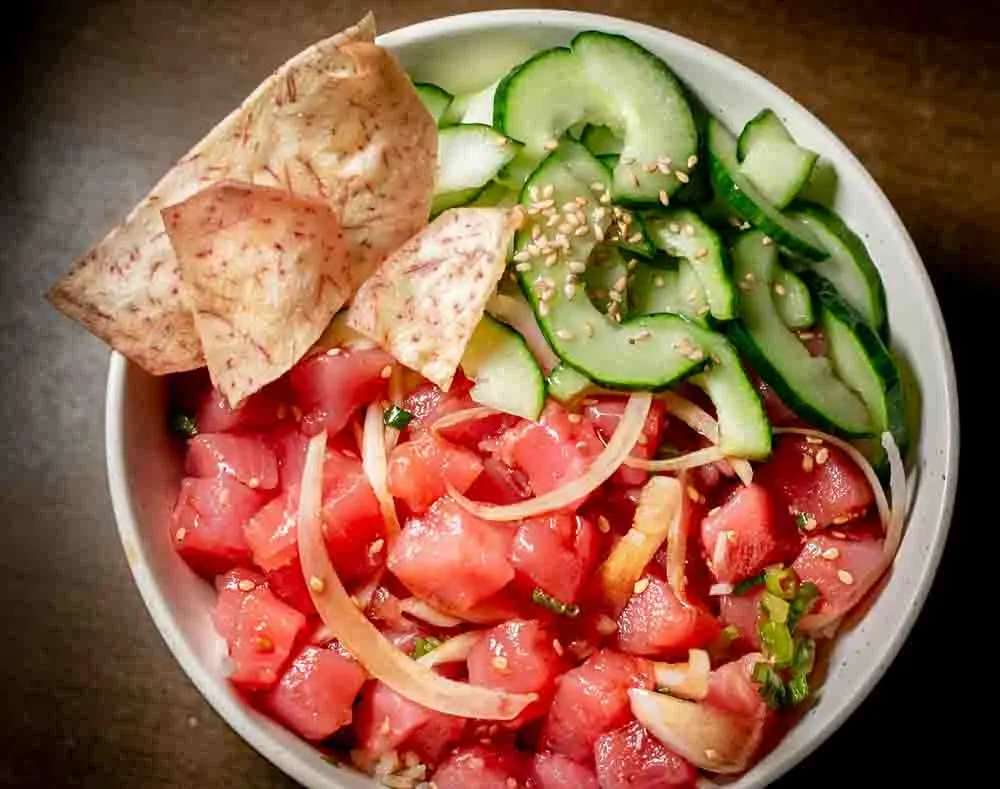
To us, eating fresh tuna, like eating a great pizza or burger, is a pleasure.
When it comes to sushi, fresh tuna is a star performer. But restaurants never seem to us give us enough of the big fish and almost always leave us wanting more. However, in poke, fresh raw tuna is abundant with big, succulent, meaty yet tender chunks present in every bite. What could be wrong with that?
What Is Poke?
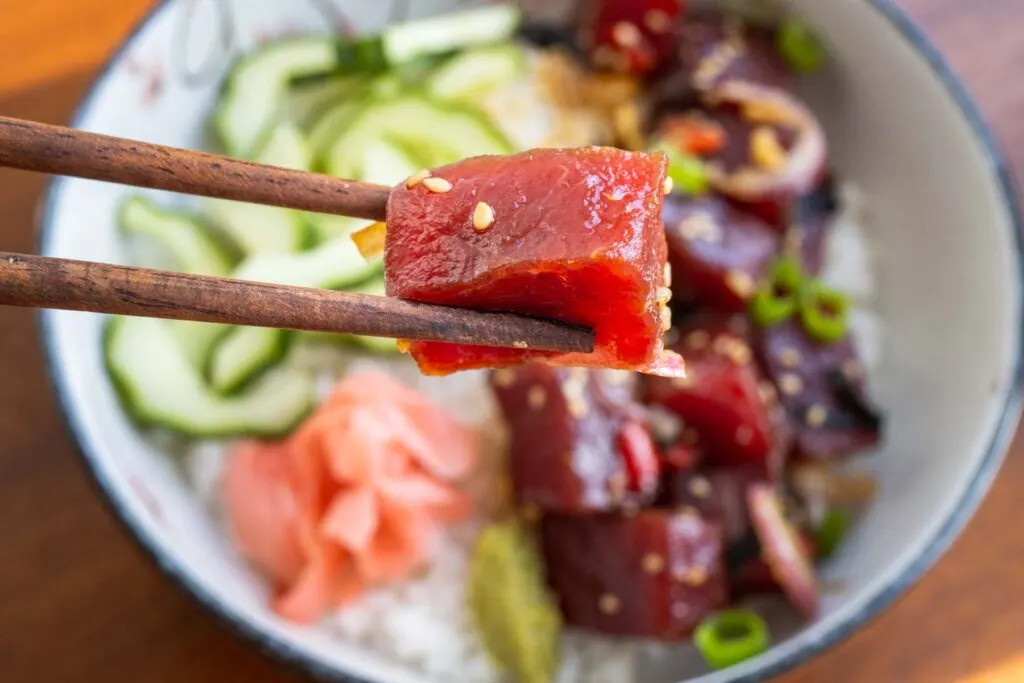
Poke is essentially chunks of marinated fish mixed with seasonings.
We’ve seen multiple interpretations of this simple definition. Some people believe the word poke translates to chunk while others believe it translates to cut into small pieces. We consider the latter translation to be the correct one.
Fun Fact
Google translates the Hawaiian word poke to Basque which makes us scratch our heads.
Then there’s the poke bowl which usually has satisfying rice at its base. Beyond rice and fish, the poke bowl’s ingredient options are immense. It can contain as many or few ingredients as you wish to use – so long as the ingredients make sense. You certainly won’t find licorice or liver in our poke bowls!
You can make your poke with tuna, our protein of choice, and add hot chilies to make a spicy tuna poke. You can add the ever trendy avocado if that’s your thing. You can also make poke with other seafood like salmon, shrimp and cooked octopus. For, a splurge you could even add caviar or salmon roe. Use your imagination. We’ve seen poke bowls made with dried meat and even a Portuguese variation made with bacalhau (i.e. salt cod).
History Of Tuna Poke
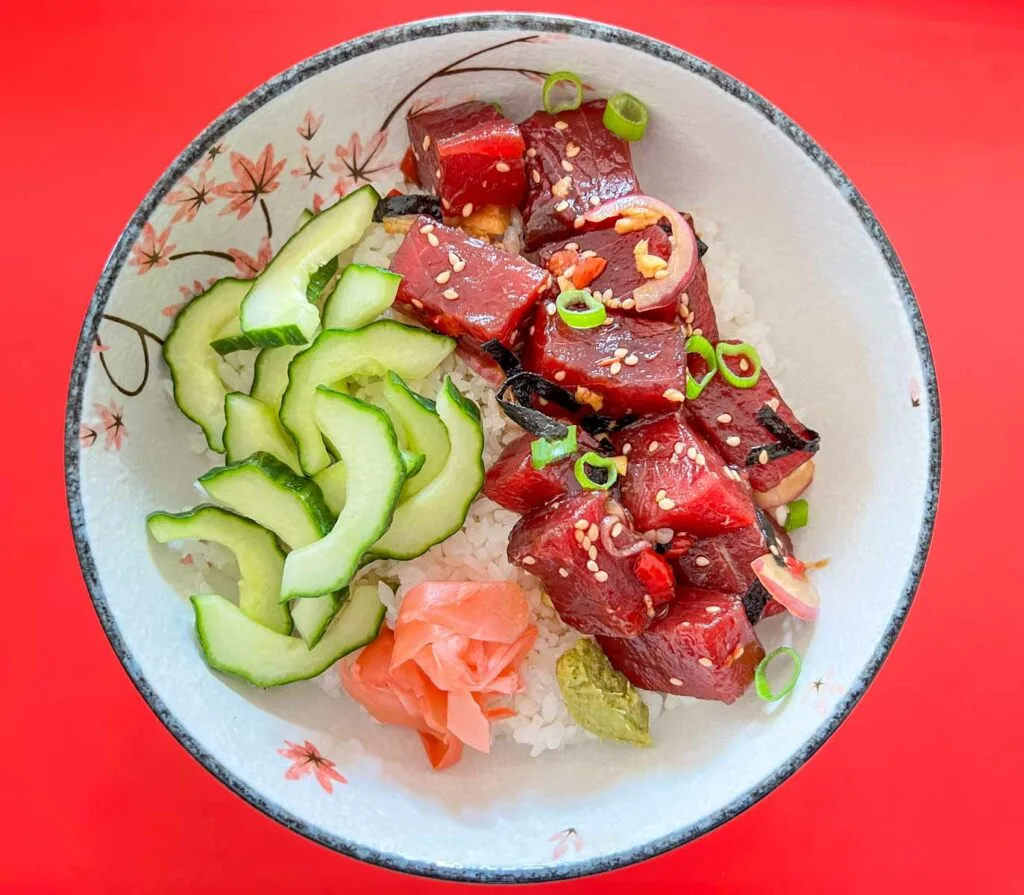
Despite its roots, the poke that Hawaiians ate a century ago has little to do with today’s modern mix of fish chunks and sauces.
Hawaiian Chef Sheldon Simeon explains in his YouTube video that poke originally consisted of only fish, seaweed, salt and local nuts like macadamia. The dish has evolved over the years, likely influenced by advances in deep sea fishing as well as the merging of eastern and western influences.
Today, poke is a more of an international dish with ingredients like soy sauce, oyster sauce, chili pepper and toasted sesame seeds.
Making Tuna Poke Bowls At Home
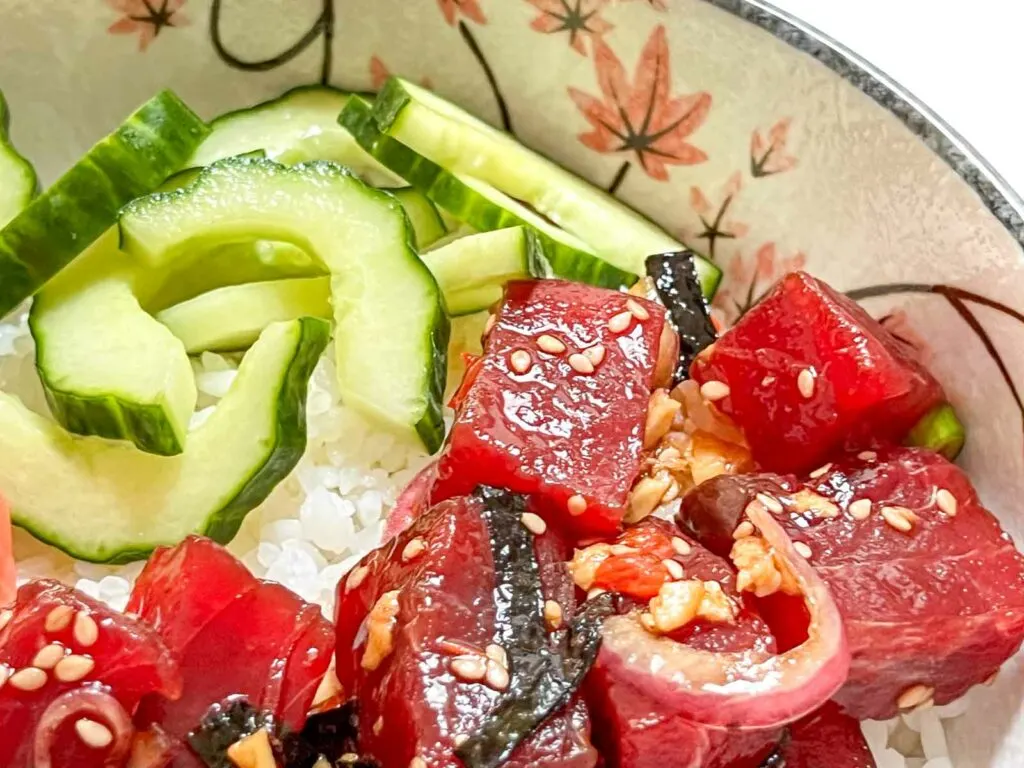
In it’s essence, tuna poke is really about the fish itself.
If you have great fish, your tuna poke should taste outstanding with just a little salt and soy sauce. In fact, if you dare to try a chunk of unseasoned raw tuna, you may find that it tastes fantastic on its own since salt water fish is salty. Duh!
But, in all seriousness, making a tuna poke bowl at home is an easy way to derive the same raw fish pleasure that you get from sushi but without chef training and high end knife skills. Make a tuna poke bowl once and you’ll be hooked. At least that’s what happened with us.
Ingredients
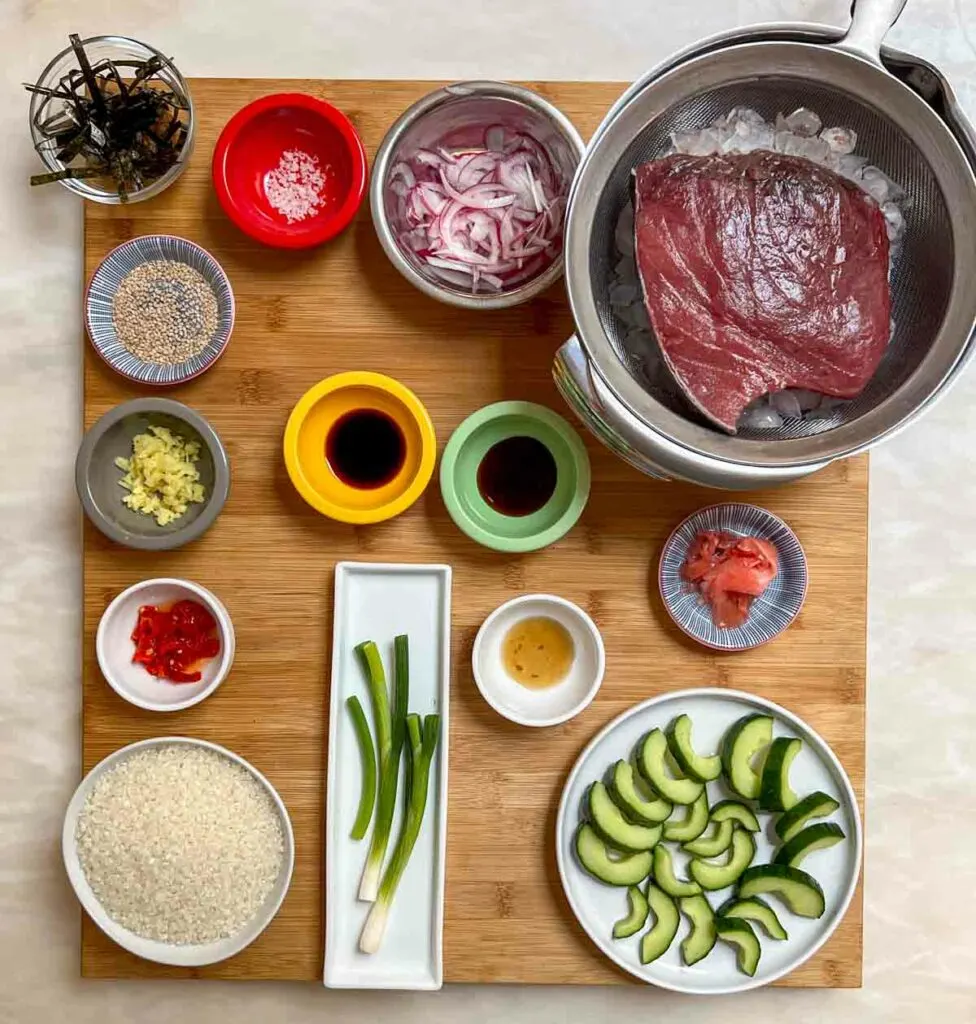
When you make tuna poke bowls at home, the ingredient options are practically endless. You can buy exotic seaweed and throw in some macadamia nuts. You can even toss in salmon eggs.
But we say start with the following ingredients, many of which are basic Asian pantry items:
Raw Tuna
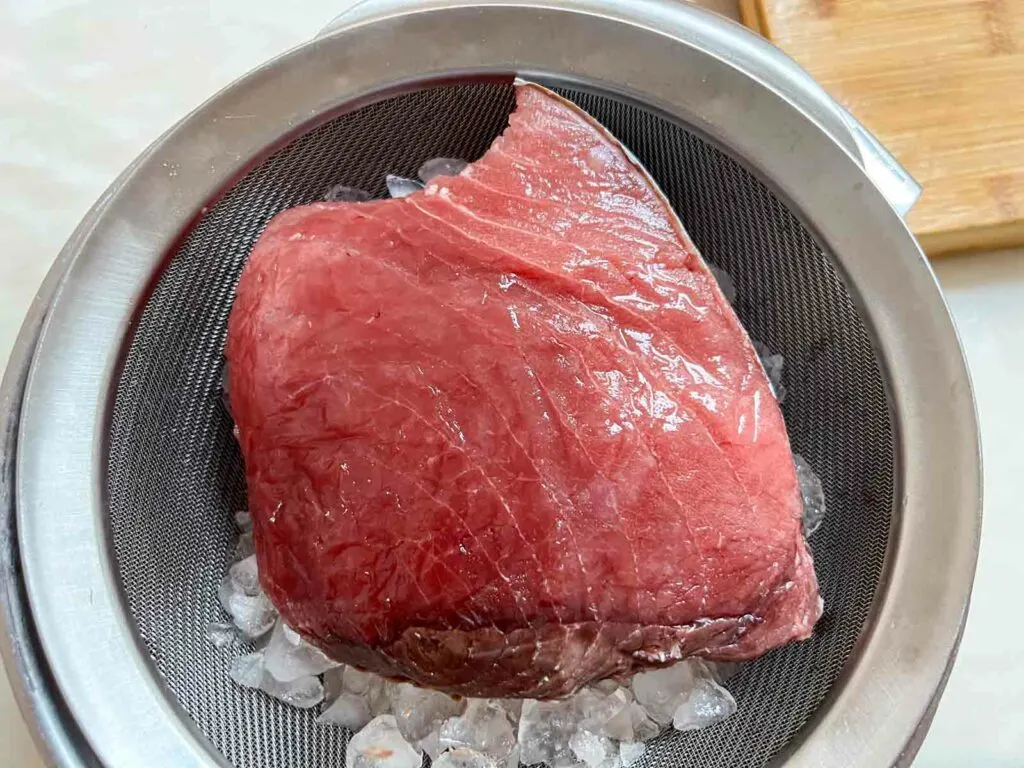
You should buy a tuna steak and cut it into cubes for this tuna poke bowl recipe.
Don’t be scared! Tuna, though expensive, won’t hurt you. The key is to buy high quality fish for your tuna poke bowl. Use your eyes. Look for bright red flesh when you shop for tuna. Sushi grade tuna is best but the key is to avoid any tuna that looks brown or discolored. One option is to buy a flash-frozen block of tuna. Or, if you live near an ocean, you can buy fresh tuna.
Pro Tip
Make sure you have the market give you a bag of crushed ice to go with the fresh fish. You can refrigerate the fish if you’re not going to use it right away. Place it on ice in a strainer over a bowl and cover with additional ice. If stored this way, the tuna should stay fresh up to two days in your refrigerator. If the ice begins to melt, you can add more as needed.
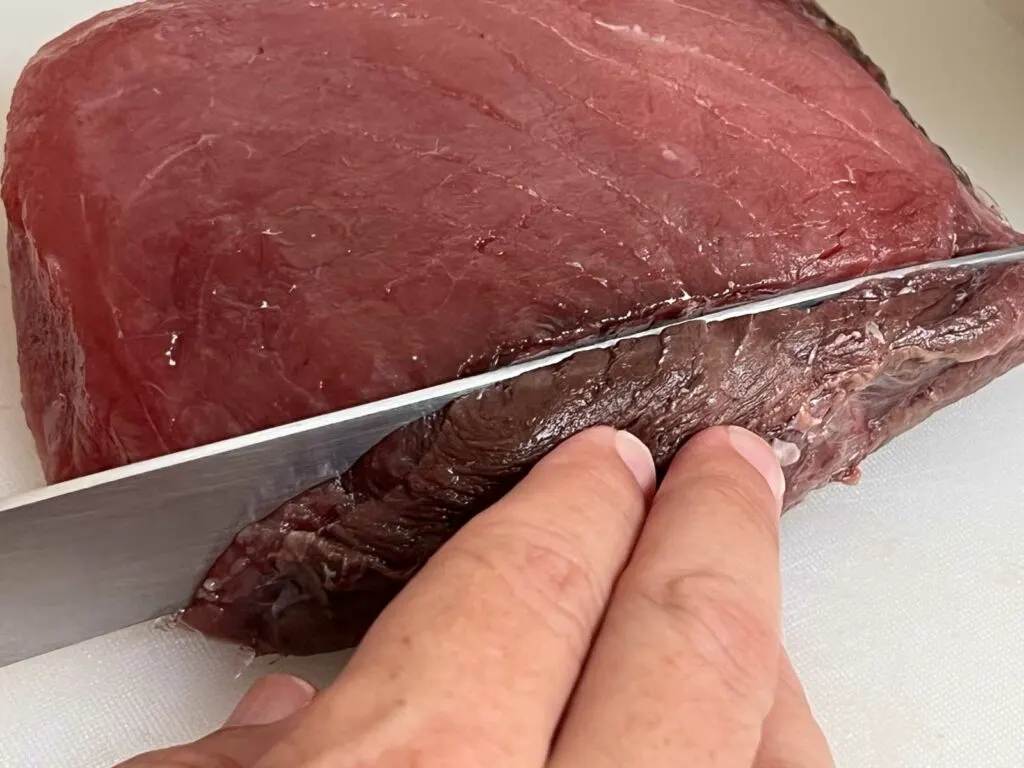
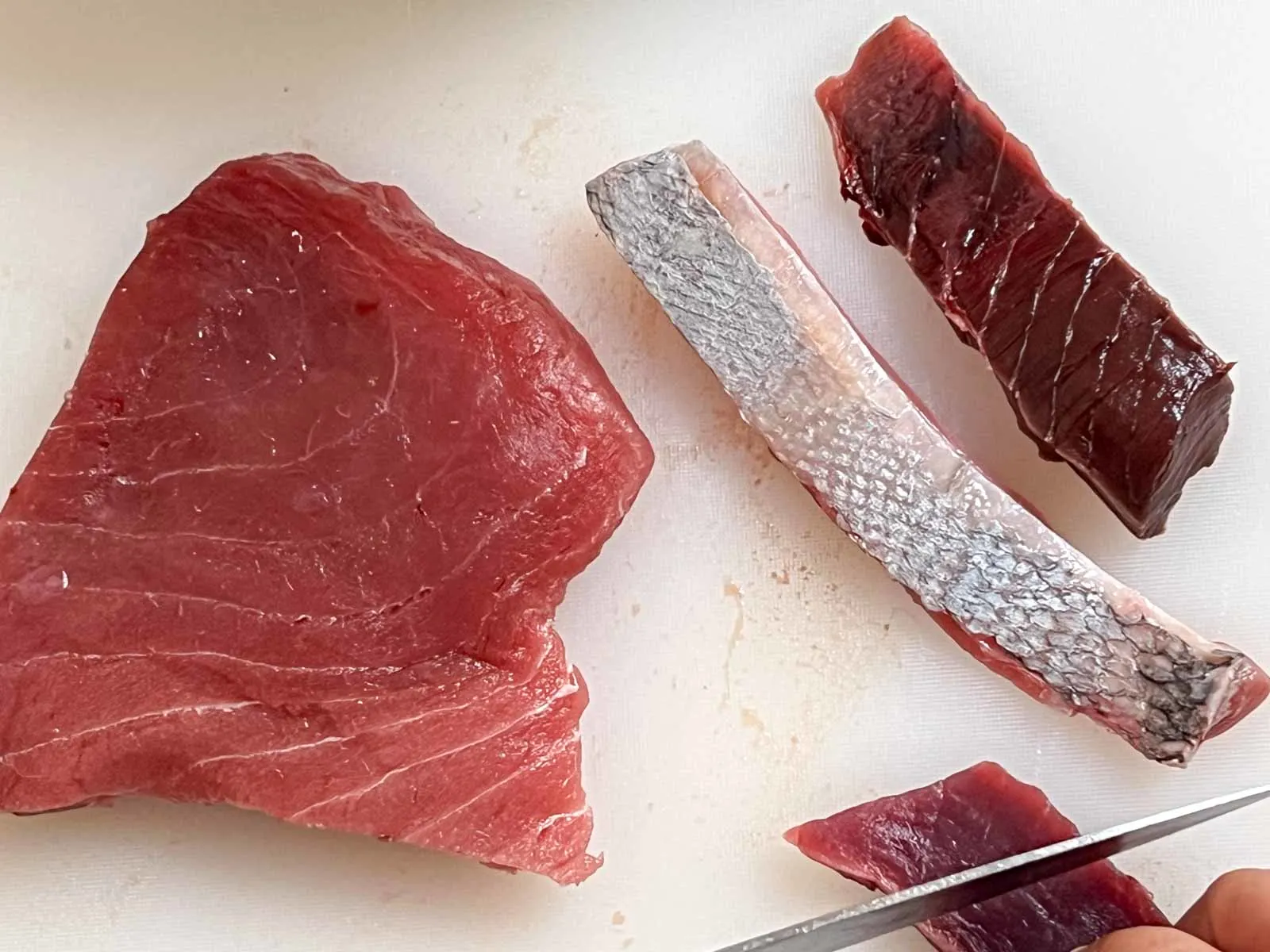
If your tuna doesn’t come in a precut block, you need to remove the skin and bloodline (the ugly dark parts) before cutting the tuna into cubes.
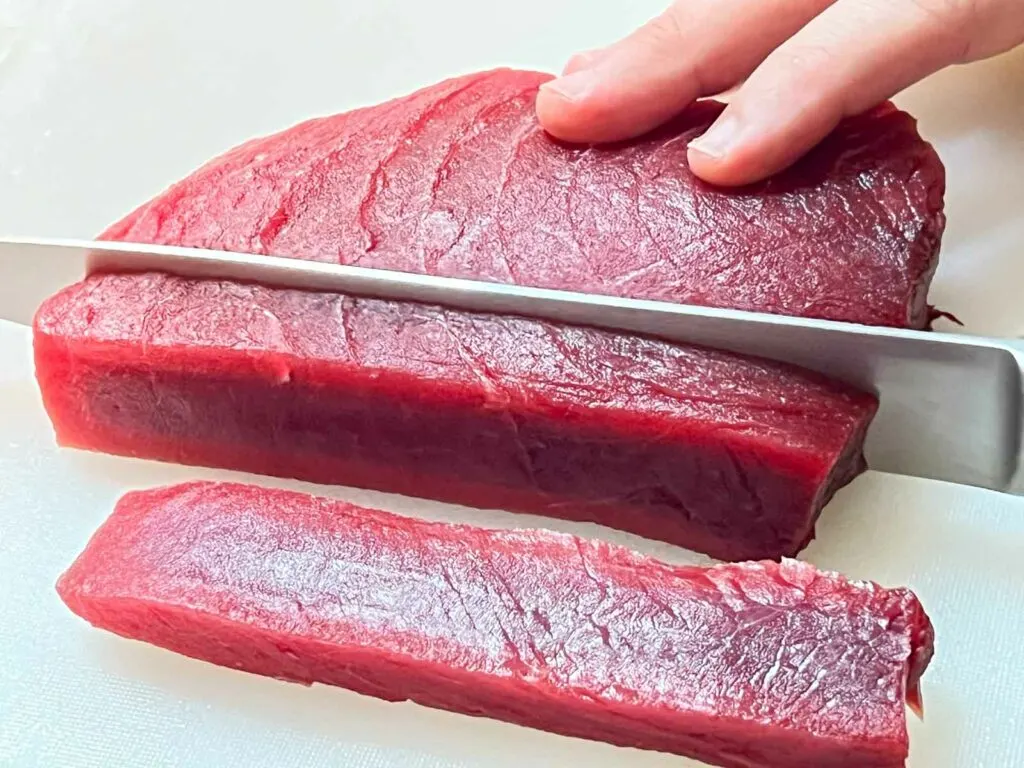
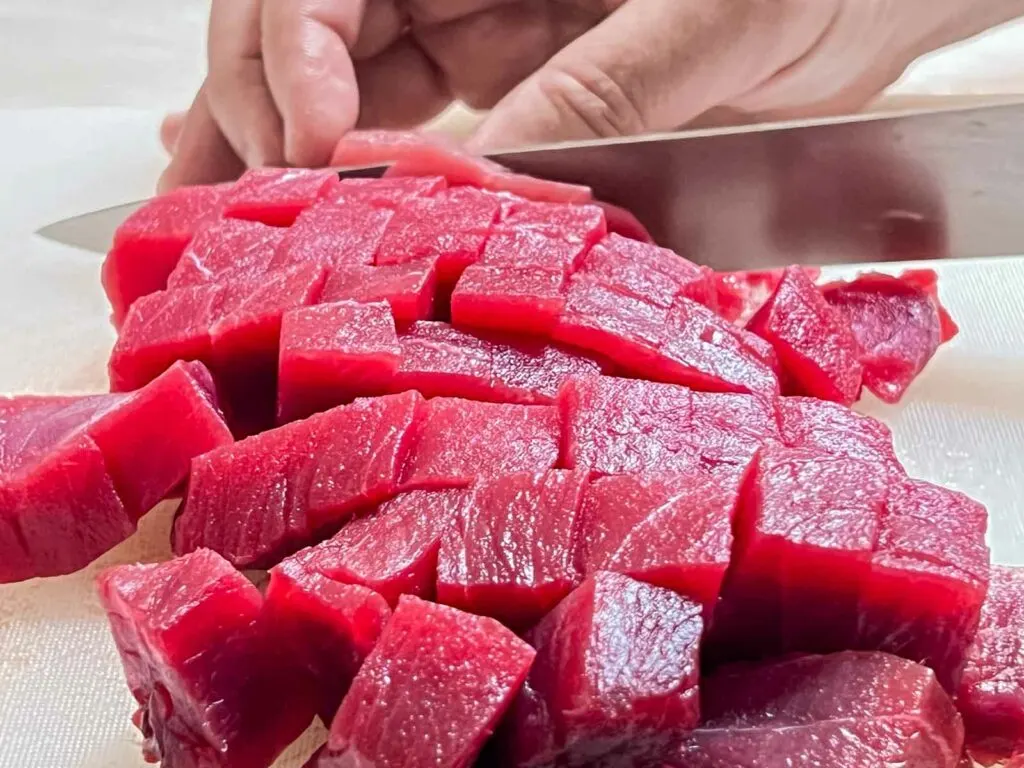
After testing this recipe a number of times, we’ve found that one-inch pieces of tuna are ideal for poke bowls. That being said, the ideal size of your poke is up to you.
Rice
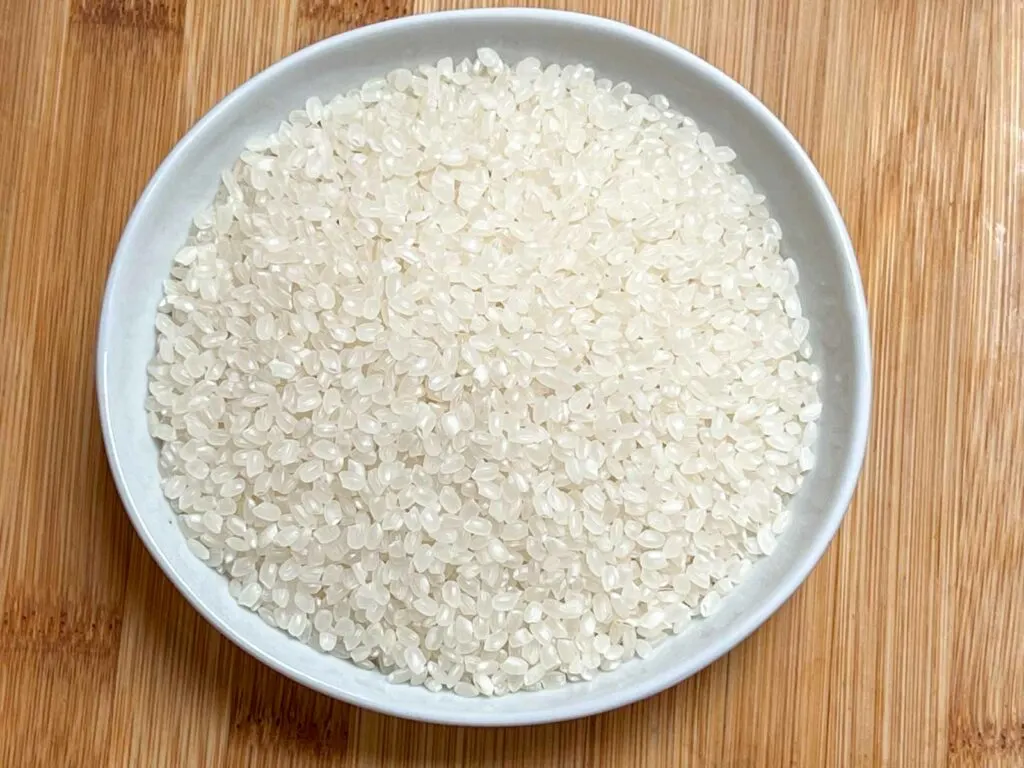
We like to use Japanese short grain sushi rice as a base in our poke bowls. We love the rice’s flavor and firm chew. However, standard long grain jasmine white rice works well too.
We also like to cook our rice in a rice cooker. How you cook your rice is up to you.
Toasted Nori (Seaweed)
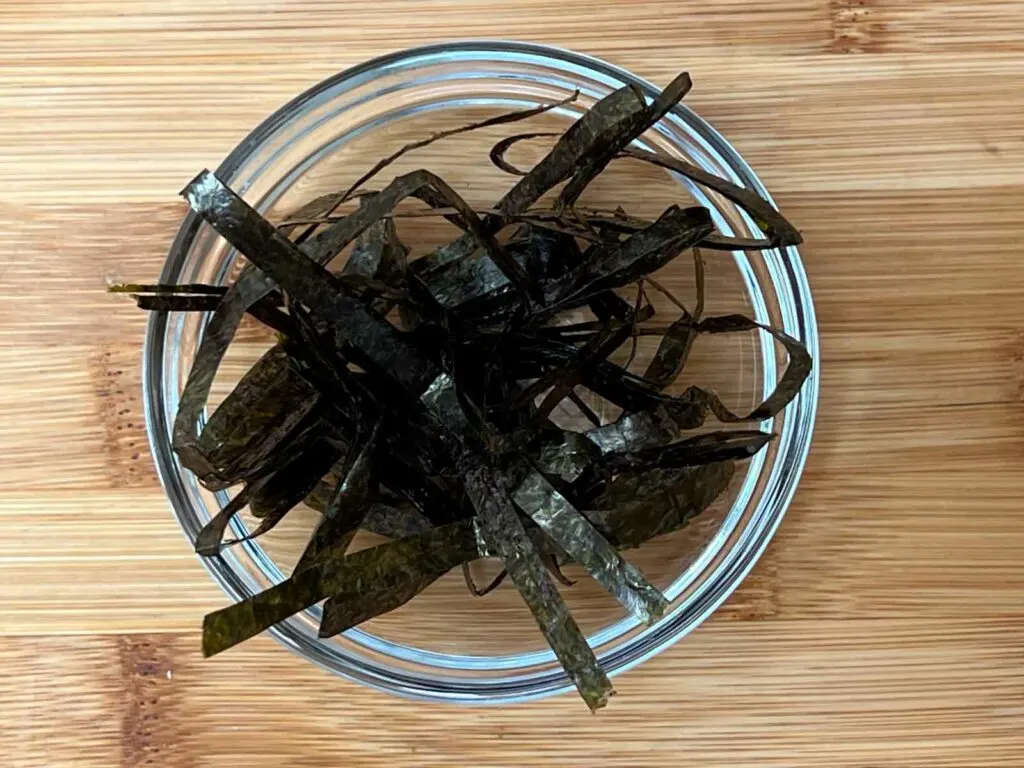
Seaweed is probably the most Hawaiian ingredient, outside of the fish itself, in our poke bowl recipe.
There are many different kinds of seaweed available but nori is the most common and easiest to find. While we’re satisfied using nori, you may want to experiment. If so, you should be able to find other kinds of seaweed at your local organic/natural foods market.
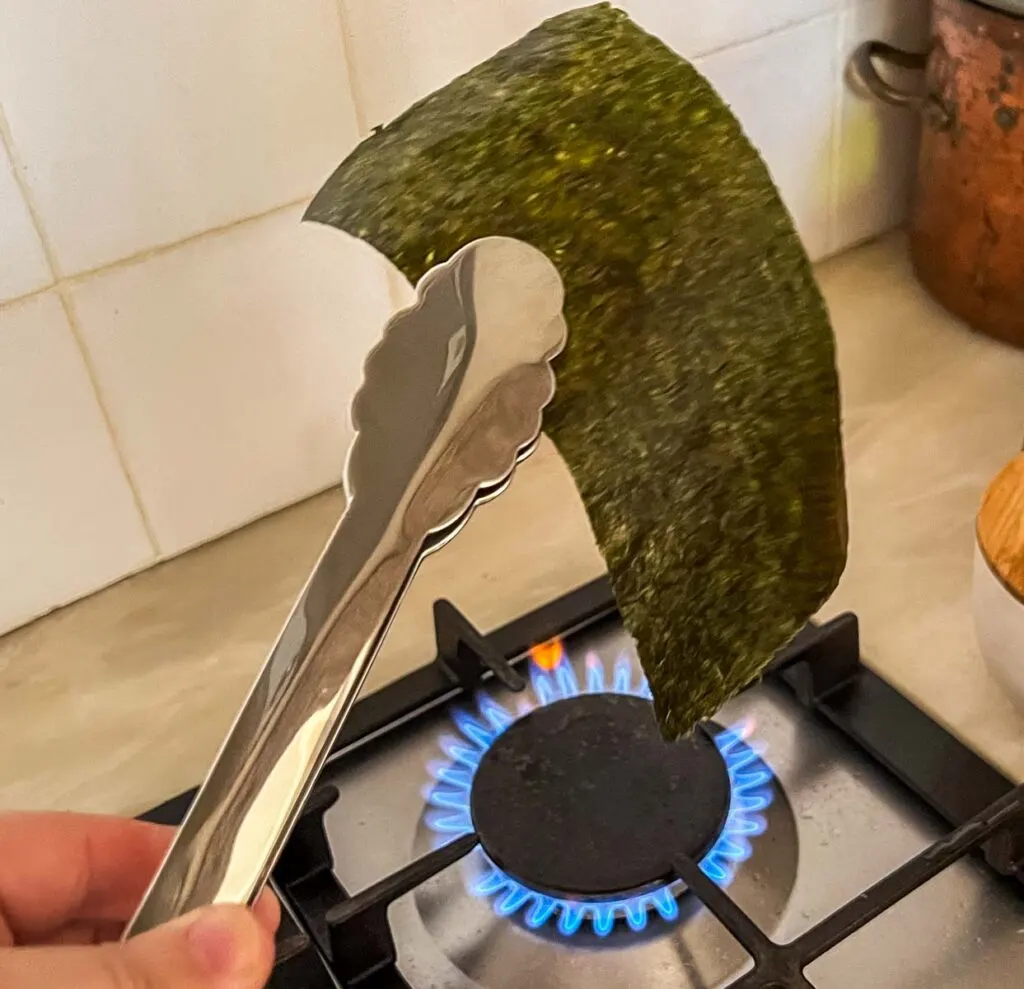
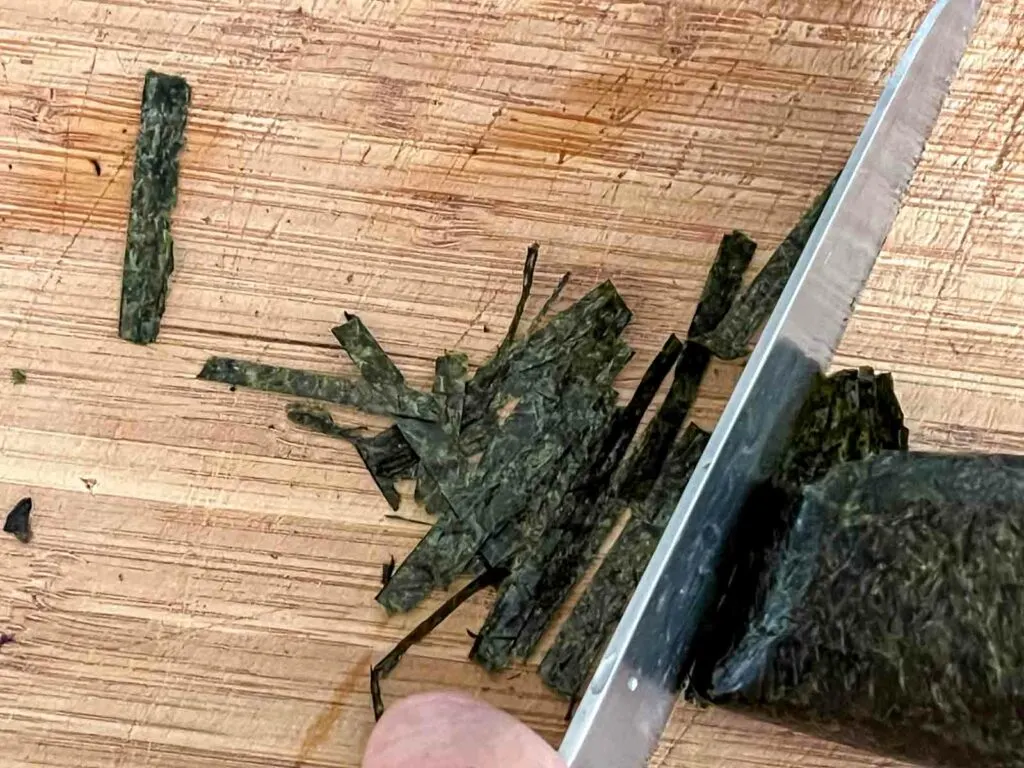
Toasting the nori is optional.
We toast our nori by carefully and lightly waving it over a flame. We then roll the toasted nori and cut it into 1/4 inch strips.
Red Onion
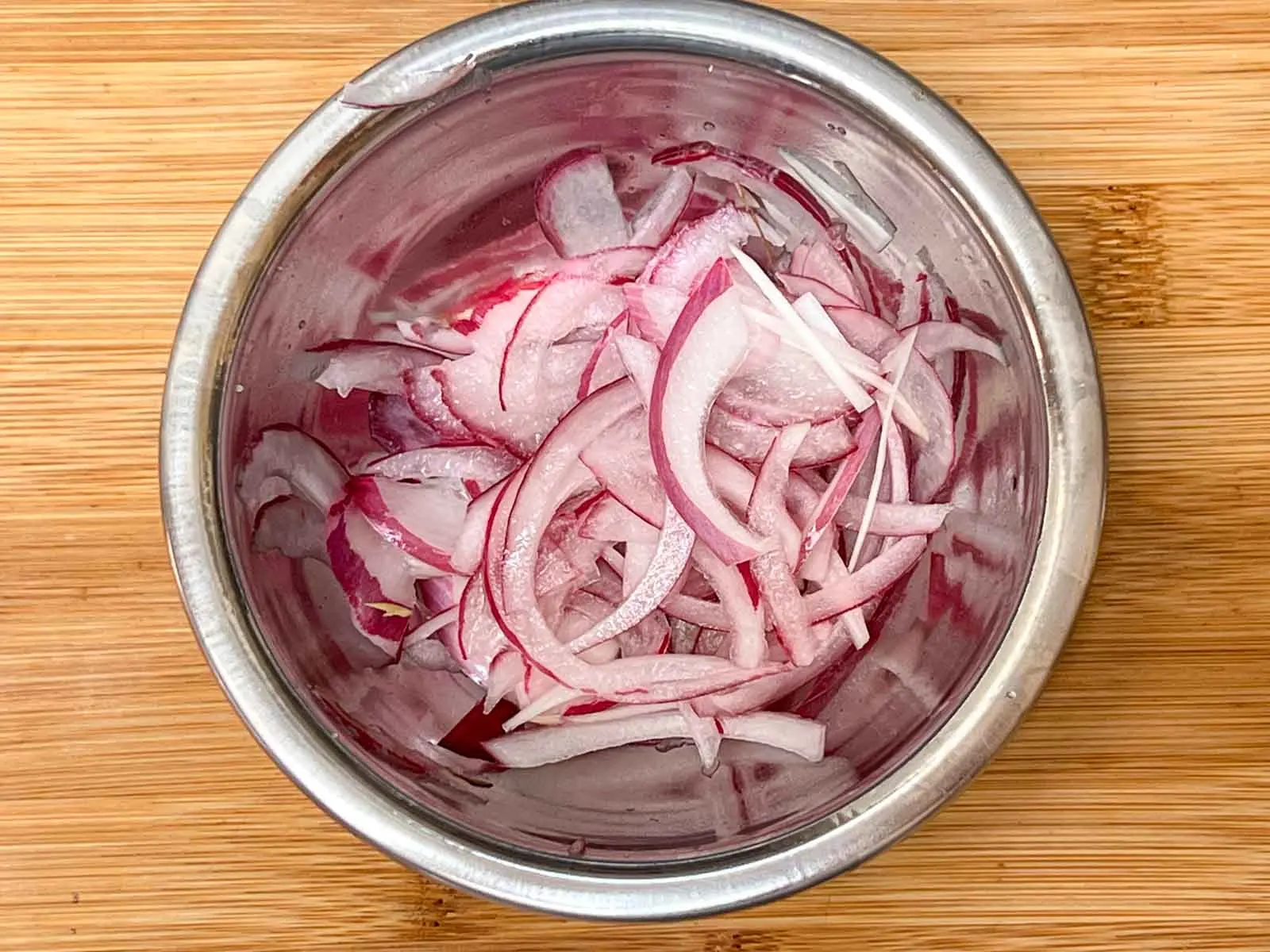
Shaved red onion gives poke a slight vegetal crunch and a hit of acidity.
We like to pickle our onion with a couple teaspoons of white wine vinegar and a pinch of salt which eliminates the harsh burn of raw onion. If you choose to pickle your onion too, we recommend pickling it about an hour before making the poke.
Soy Sauce
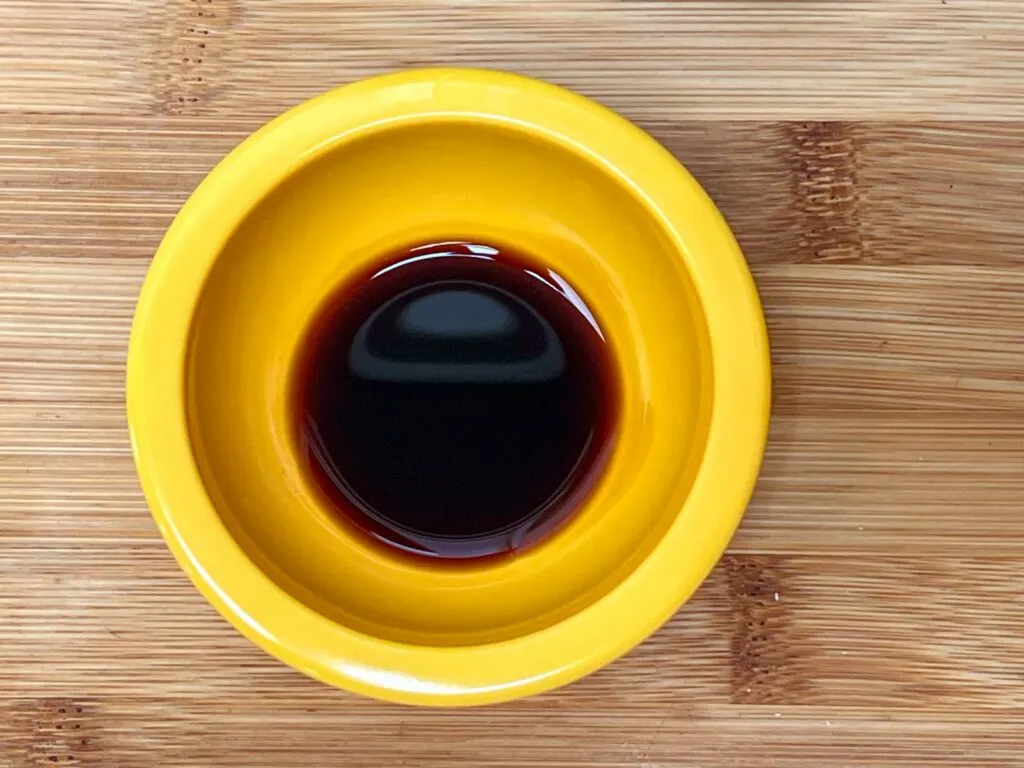
The idea of adding soy sauce added to poke most likely came from Japan but that’s not the reason why we use Japanese soy sauce when we make tuna poke bowls at home.
Japanese soy sauce has a thicker consistency and maltier flavor. It also conveys the kind of flavor we’re accustomed to tasting when we eat raw fish.
Sesame oil
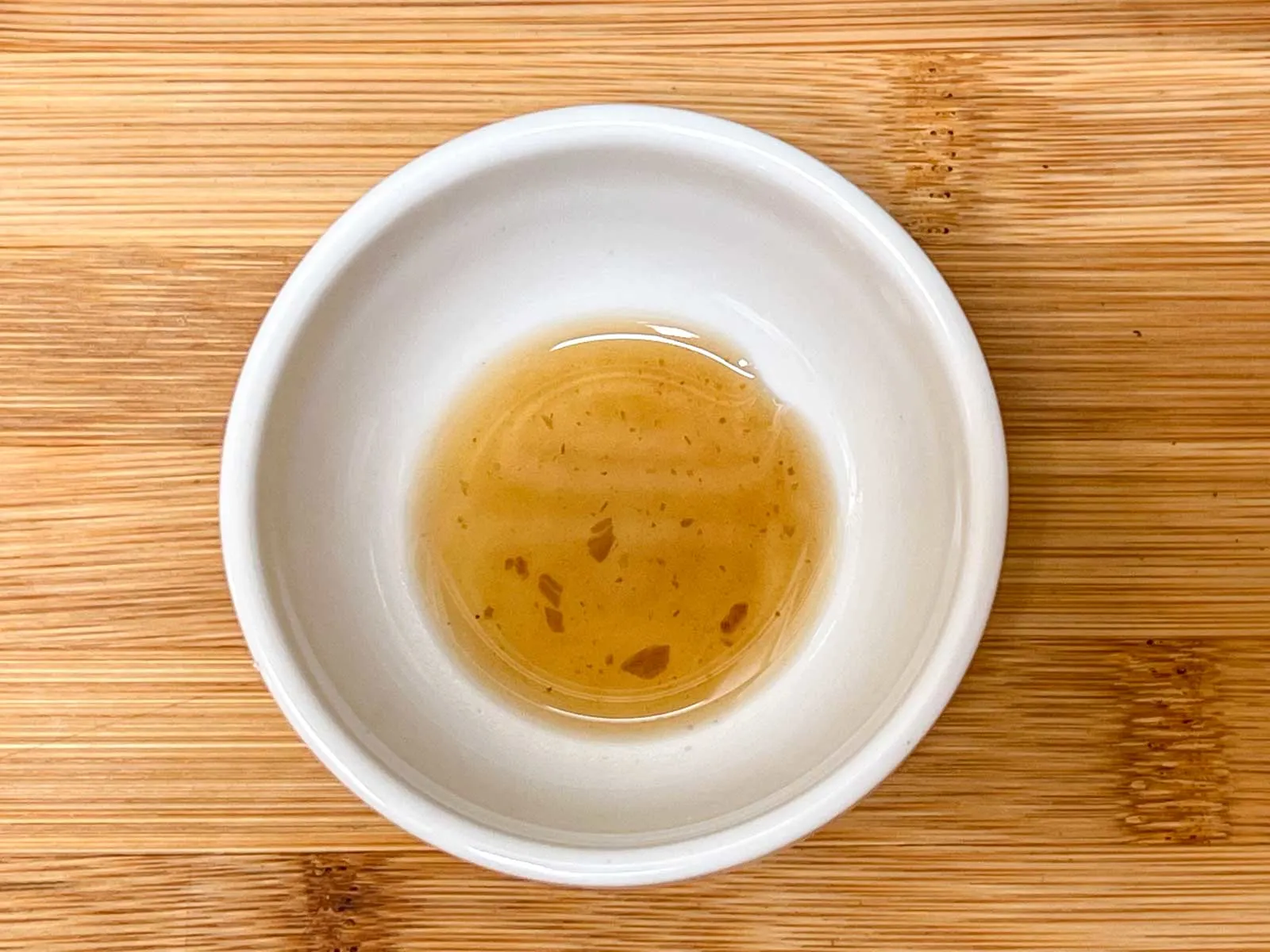
Toasted sesame oil has an excellent nutty flavor that adds dimension to our tuna poke. A little bit goes a long way in this recipe.
Cucumber
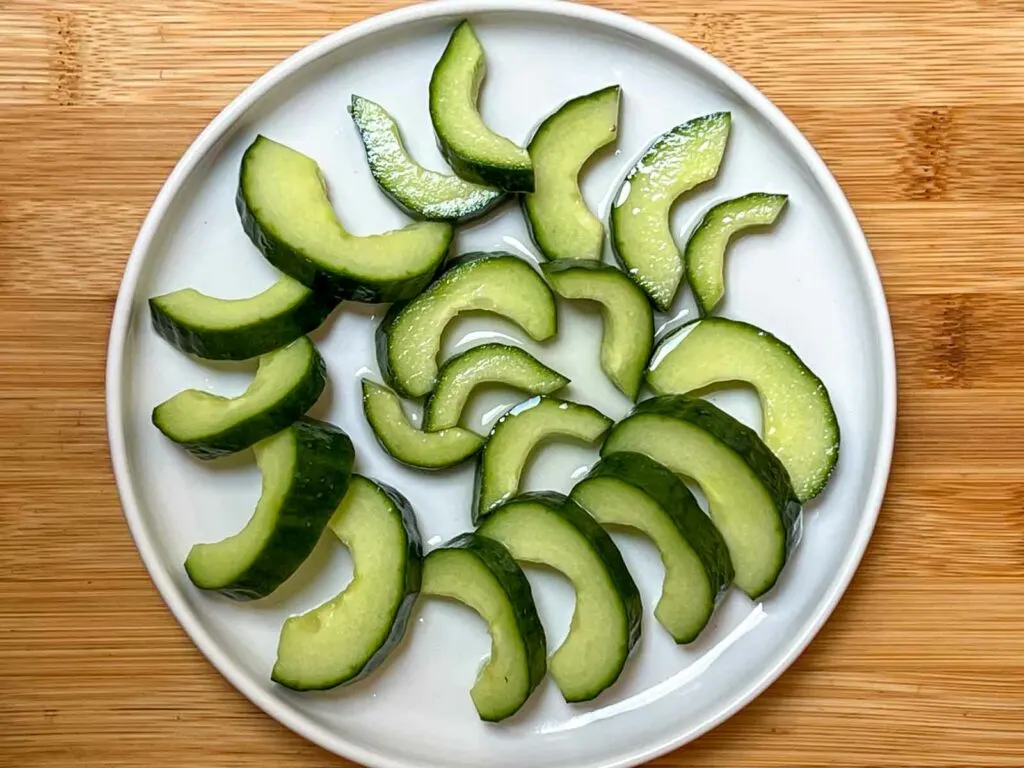
Cucumber is a poke bowl ingredient that we rarely skip. The green vegetable adds fresh flavor and texture to the dish’s rich rice and fish.
We recommend using an English cucumber with the seeds removed. And, as with the red onion, you can pickle the cucumber with a teaspoon of white wine vinegar and a pinch of salt before using it.
Pickled Chili
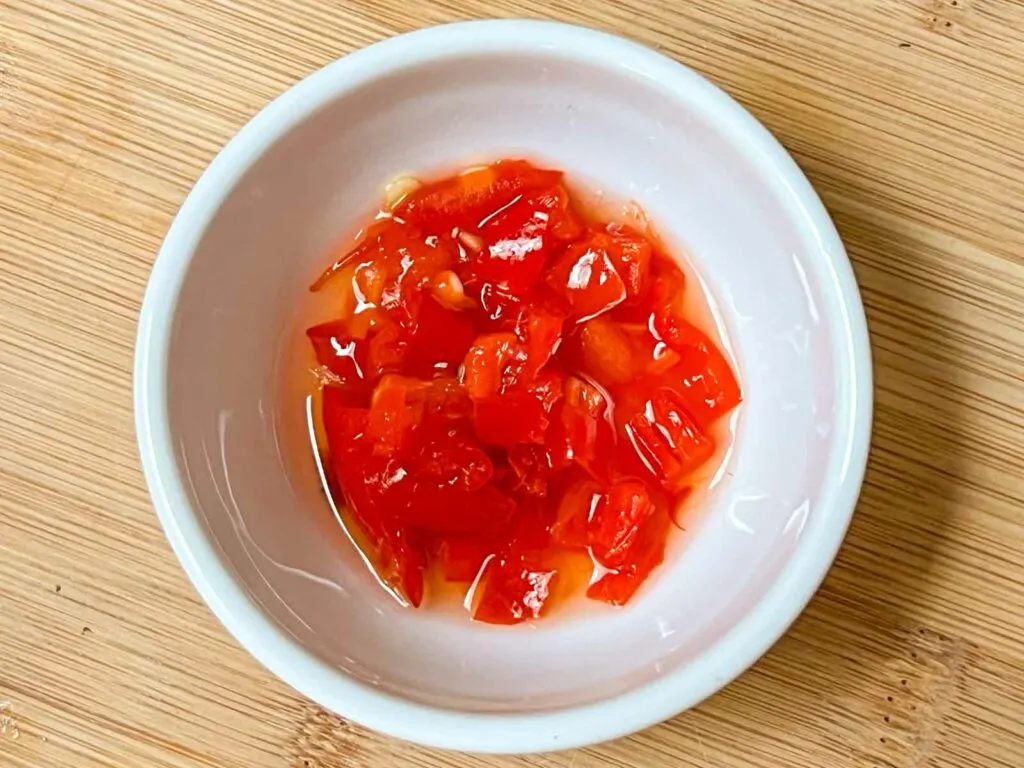
Pickled chili brings a dose of chili flavor and a just a touch of heat. You should be able to find a jar at your local Asian market.
Pro Tip
Pickled chili tastes great on sandwiches too.
Toasted Sesame Seeds
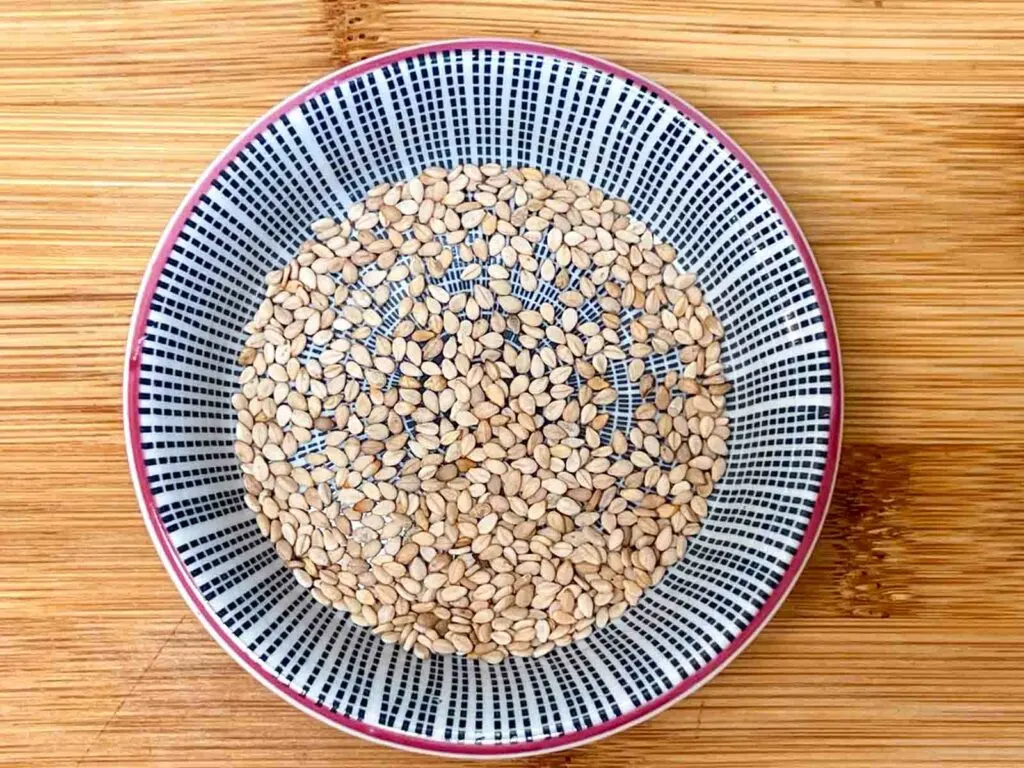
Adding toasted sesame seeds serves two purposes. Not only does it provide a textural element but it’s also aesthetically pleasing.
We buy our sesame seeds already toasted. If you like them darker, you can toast them yourself by placing the seeds in a pan over a low fire for about two minutes.
Oyster Sauce
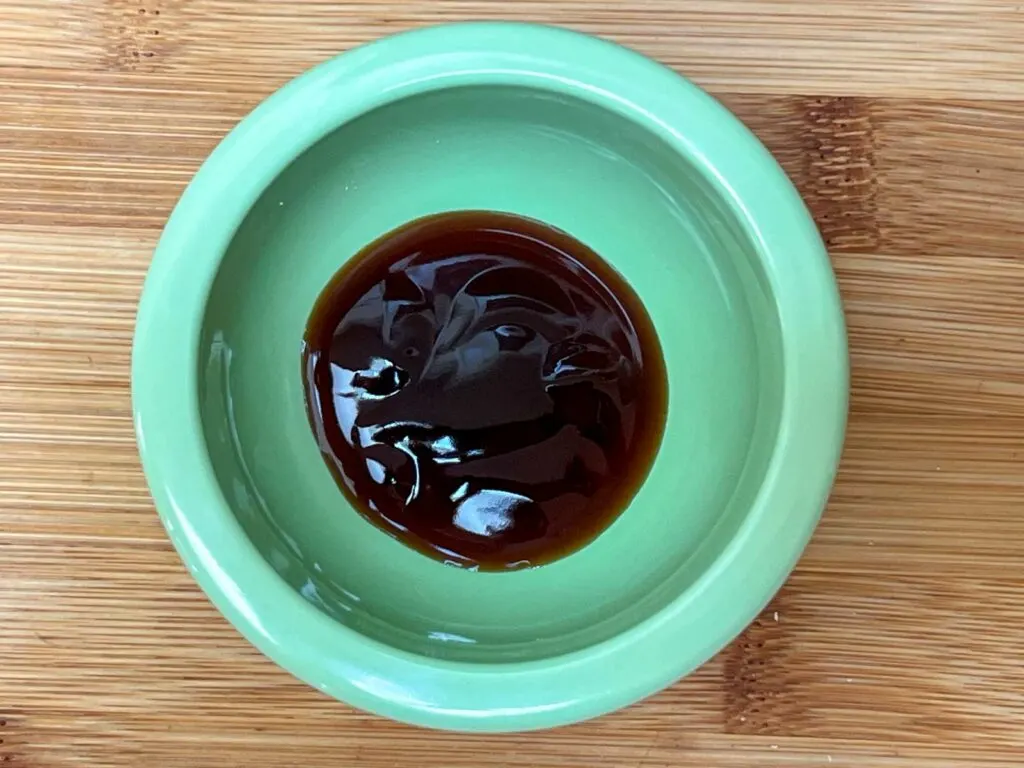
Oyster Sauce adds a dimensional element of slightly sweet umami to poke. It also adds richness.
Fresh Ginger
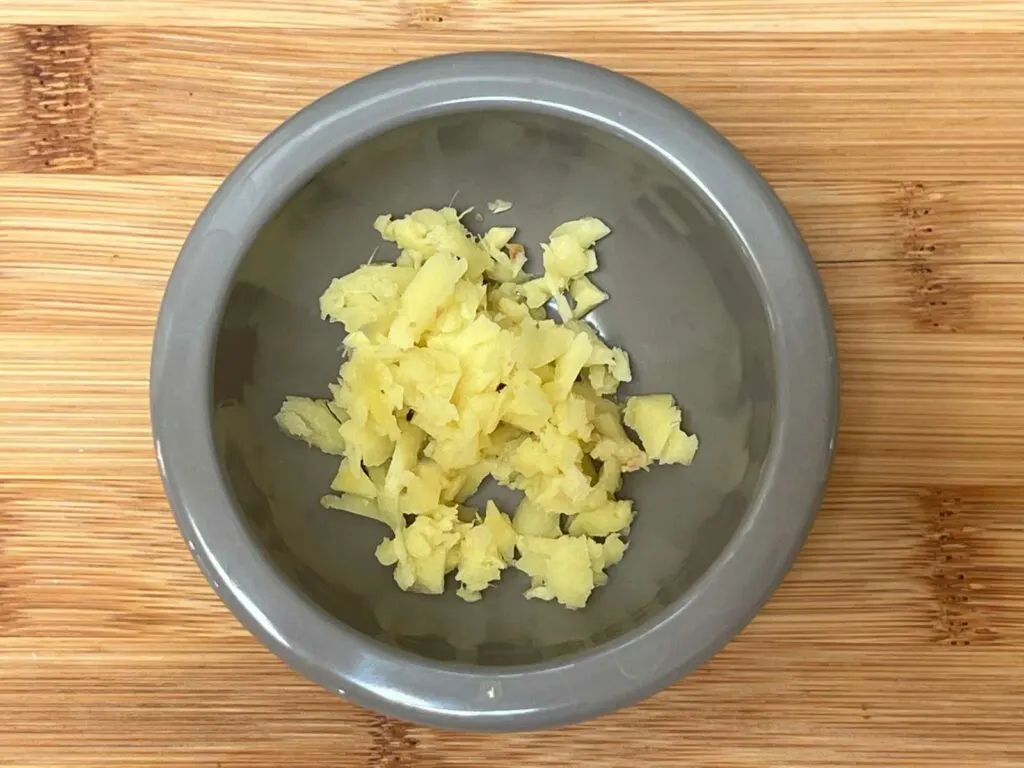
Ginger adds a Chinese dimension to tuna poke. You should be able to buy fresh ginger at your local market.
Salt
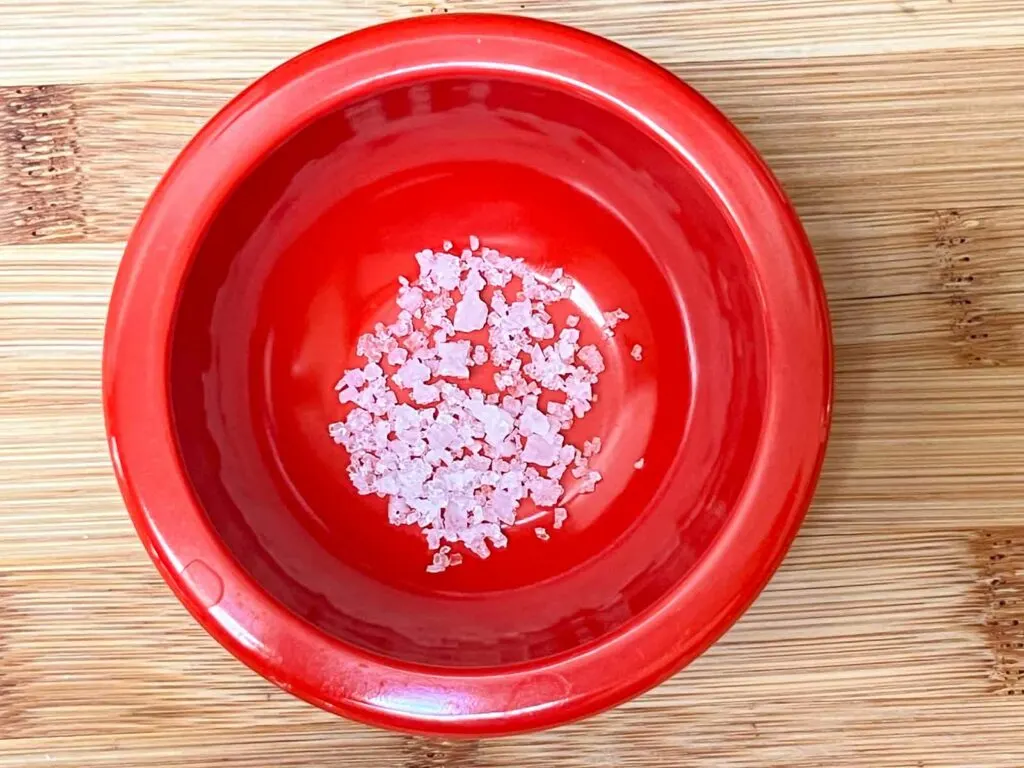
Salt brings the flavors of the tuna to life but don’t use too much. It’s important, with all the salty elements happening in this dish, to salt to taste.
Scallion
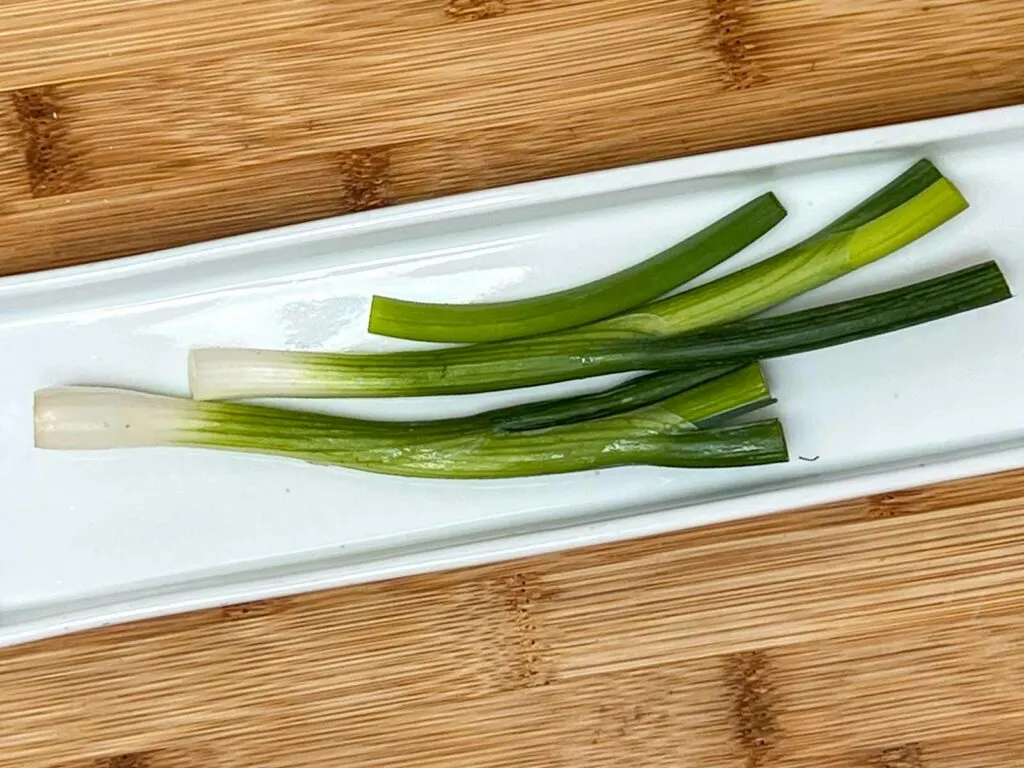
Scallions bring a verdant, grassy fresh flavor to tuna poke recipe. You should be able to find them at your local market.
Pickled Ginger and Wasabi
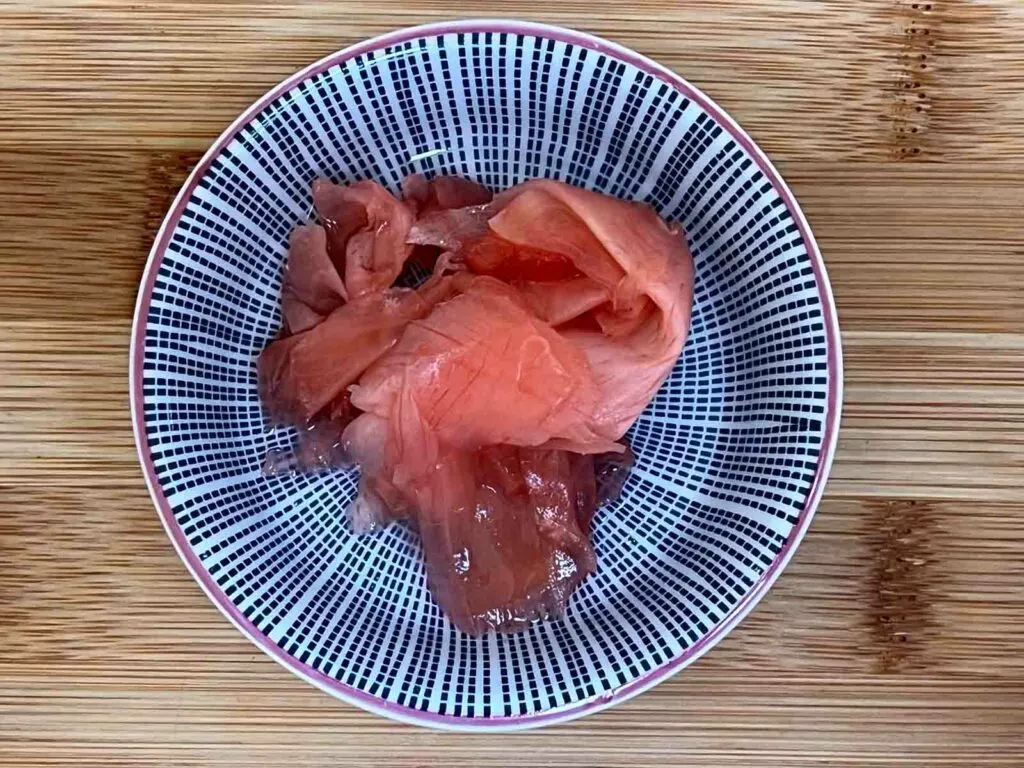
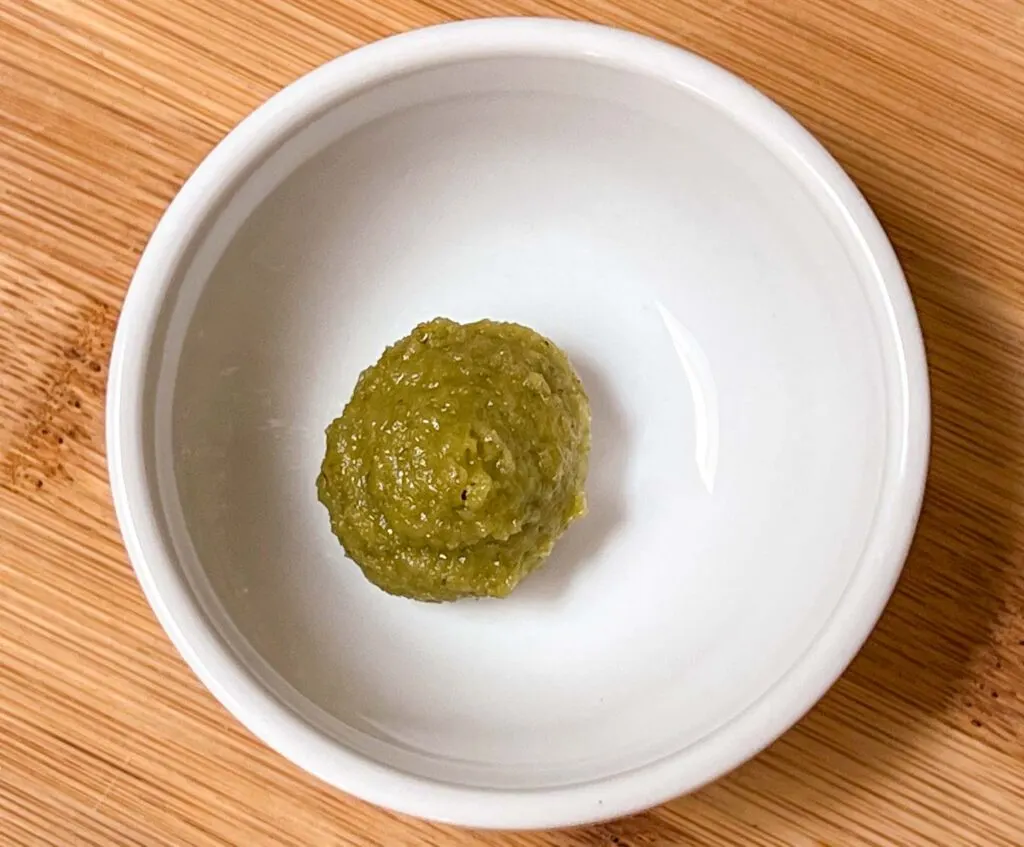
If you like sushi, as we do, you probably enjoy eating raw fish with palate-cleansing ginger and nose-electrifying wasabi. These ingredients, while satisfying, are optional in this tuna poke bowl recipe.
Finding affordable fresh wasabi isn’t so easy. However, wasabi/horseradish blends (the kind you’ll find in most middle and low end Japanese restaurants) are sold both in tubes and in powder form at most Asian food markets. Pickled ginger should be equally easy to find at your local Asian market.
How To Make A Tuna Poke Bowl
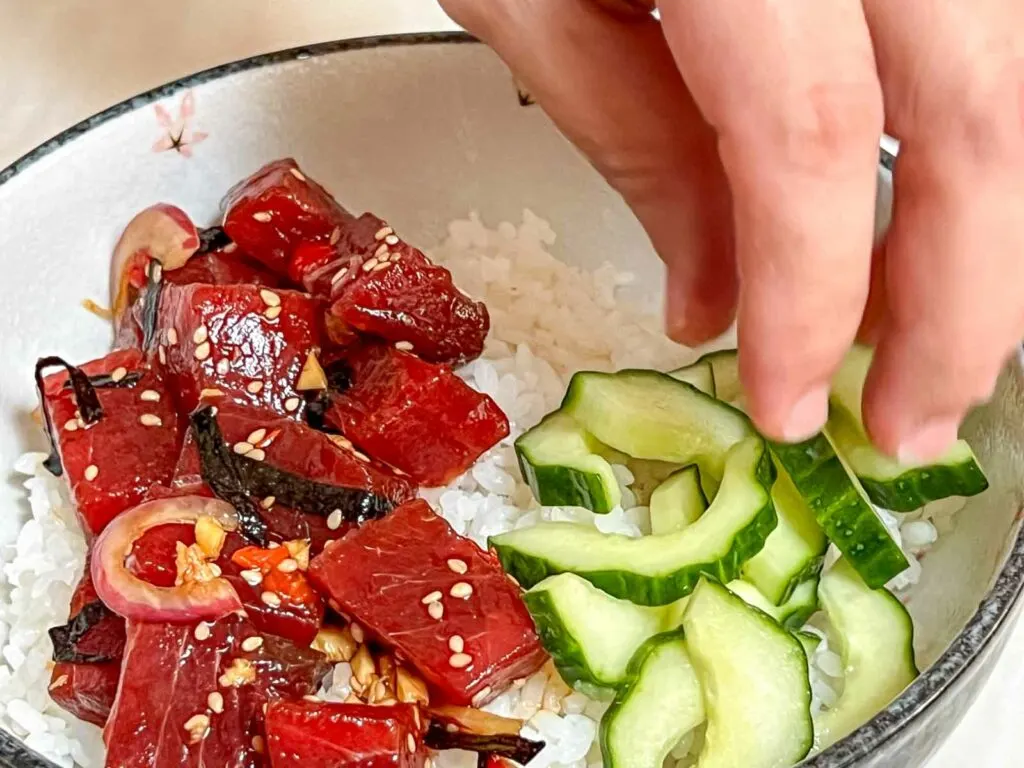
Good news! Once you assemble all of the necessary ingredients, the only thing you have to do is cut the fish in uniform chunks and mix everything together.
The first step is to cut the tuna in uniform one-inch chunks.
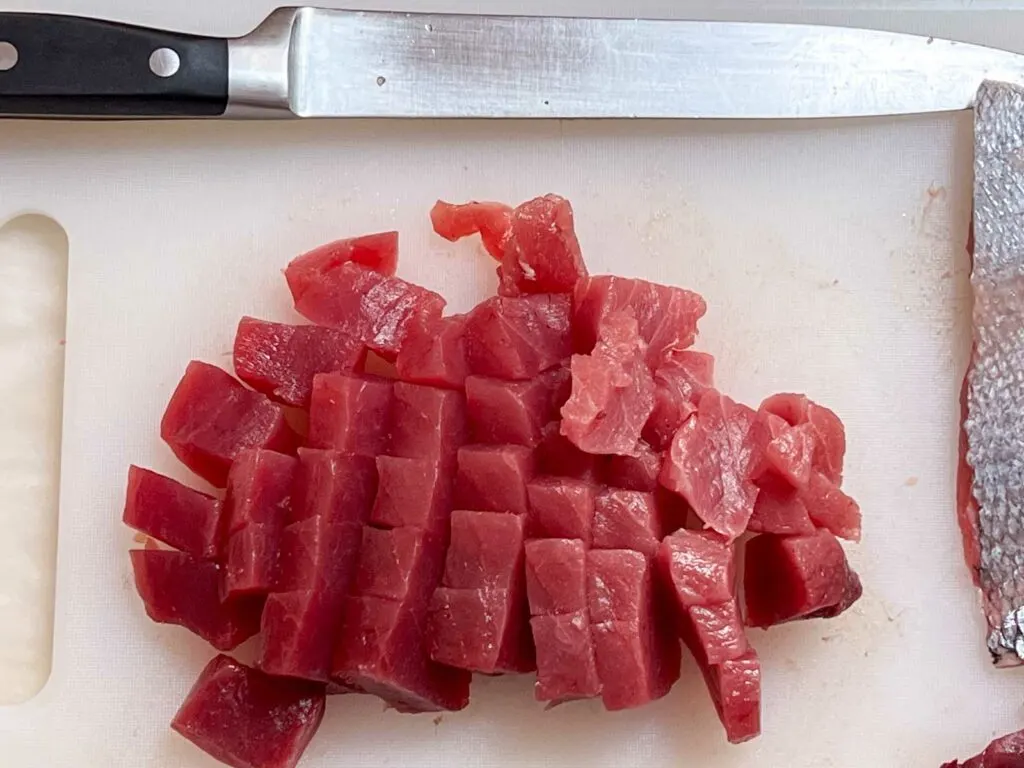
Place the poke (i.e. tuna chunks) in a mixing bowl. Add all of the ingredients with the exception of the cucumber, rice, pickled ginger, wasabi and any other fun ingredients you wish to add when you plate the dish.
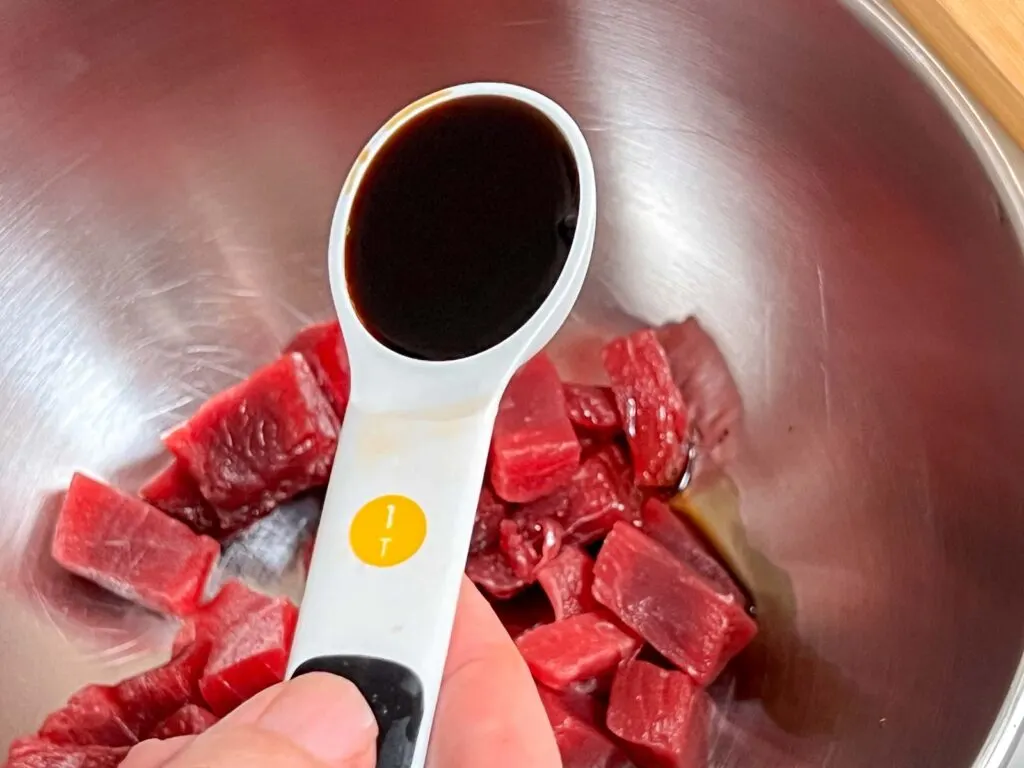
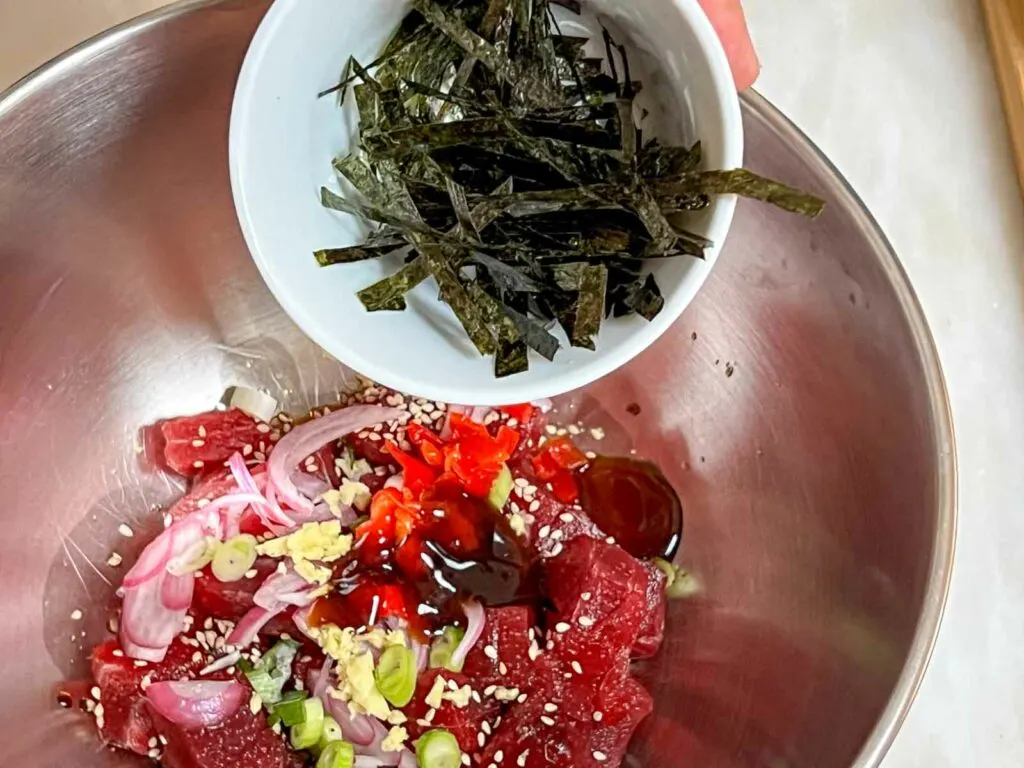
After you place the rice in a bowl, creatively place the poke and the complimentary ingredients in a neat arrangement around your bowl.
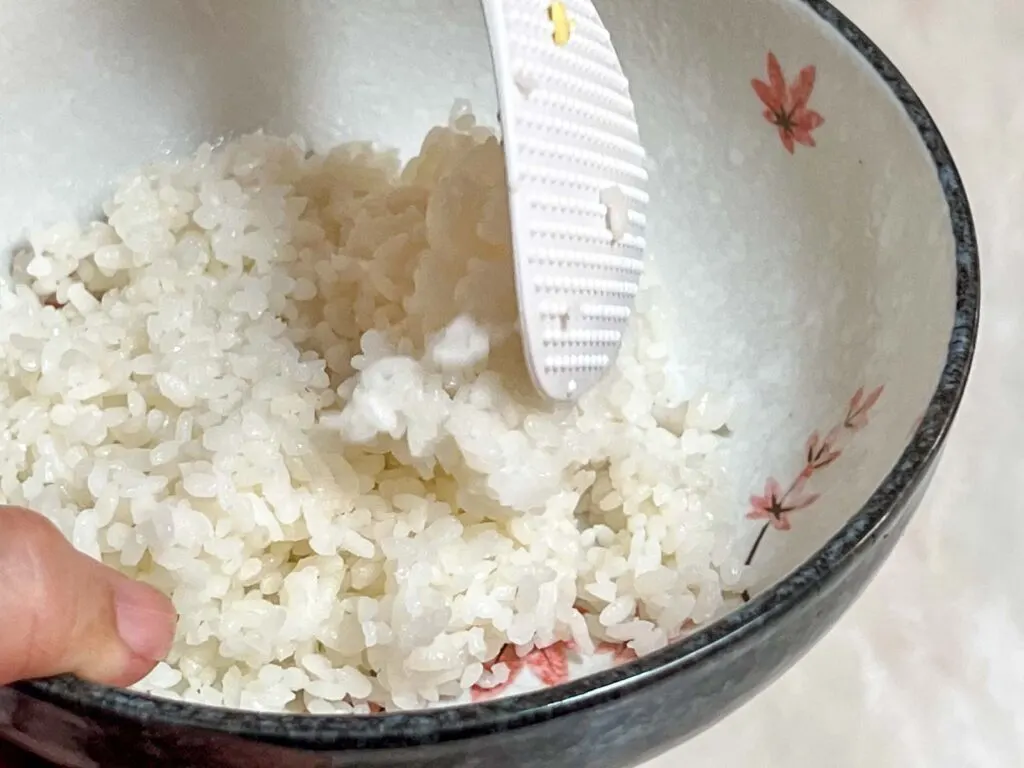
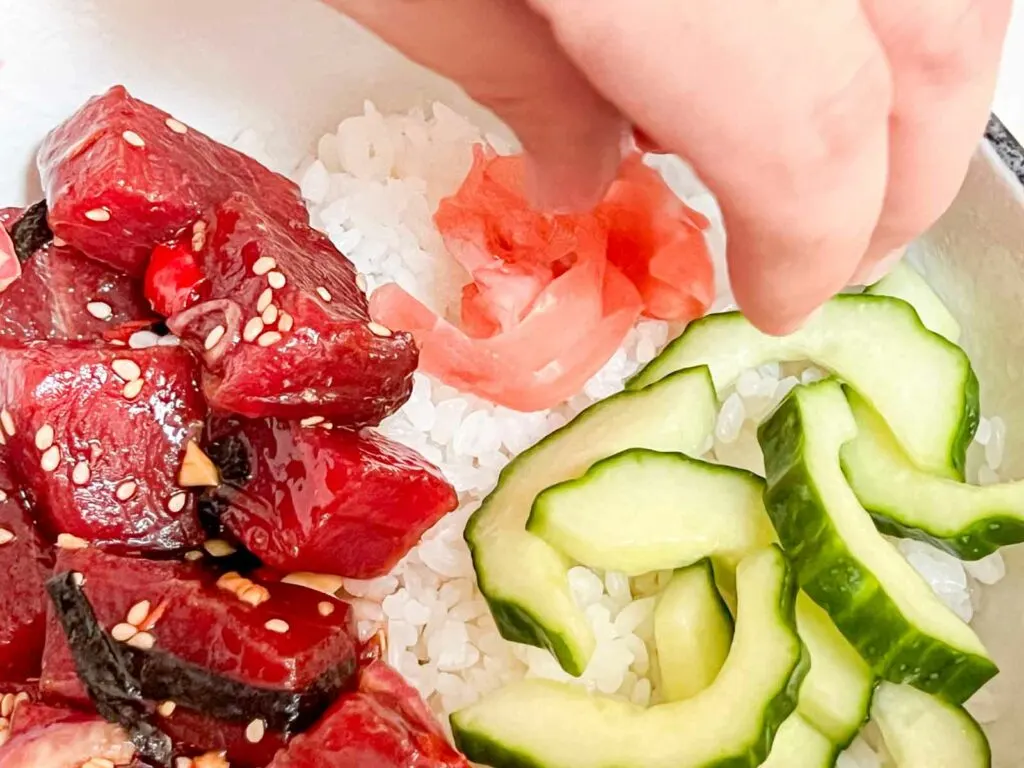
Serve with chopsticks unless you’d rather use a knife and fork.
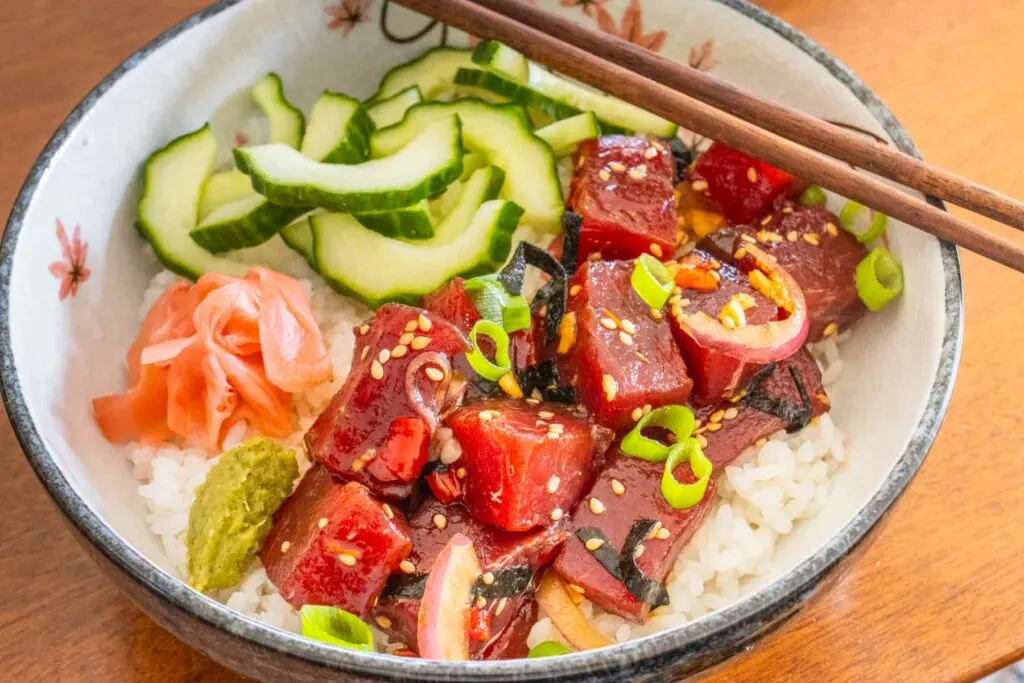
Frequently Asked Questions
Tuna poke is essentially chunks of marinated tuna mixed with seasonings.
Tuna poke originated in Hawaii.
Beyond raw tuna, typical tuna poke ingredients include cucumber, fresh ginger, nori, oyster sauce, pickled chili, red onion, rice, salt, scallion, sesame oil, soy sauce and toasted sesame seeds. Pickled ginger and wasabi add the dish’s finishing touches.
Tuna poke is typically made with raw tuna that’s been marinated in soy sauce and sesame oil.
While raw tuna is thinly sliced for sushi, raw tuna is marinated and cut into chunks for poke.
Tuna poke is easy to pronounce once you realize that ‘poke’ has two syllables. It sounds like too-na poh-kay.
Tuna poke is typically high in protein and low in fat.
Did you make this recipe? If so, please rate it below.
Tuna Poke Bowl Recipe
Ingredients
- 8 ounces raw tuna
- 4 cups cooked rice
- ¼ red onion (sliced and lightly marinated in vinegar and salt)
- 1 scallion (thinly sliced – white and light green part only)
- ¼ sheet nori (sliced into 1/4 inch strips)
- 1 teaspoon toasted sesame seeds
- ½ cucumber (seeds removed, sliced into 1/4 inch strips and lightly marinated in vinegar and salt)
- ½ teaspoon toasted sesame oil
- 1 teaspoon Japanese soy sauce
- ¼ teaspoon salt (to taste)
- ½ tablespoon oyster sauce
- 1 tablespoon pickled chili
- 1 tablespoon fresh ginger (minced)
- 2 tablespoons pickled ginger (optional garnish)
- 2 teaspoons wasabi paste (optional garnish)
Equipment
Instructions
- Use a sharp slicing knife to cut the tuna into 1 inch cubes. Remove the blood line and skin from the tuna if necessary
- Place the tuna in a medium metal bowl. Add the sliced red onion, scallion, nori, soy sauce, sesame oil, oyster sauce, fresh ginger, pickled chili and salt. Gently mix with a spoon until the ingredients are combined.
- Split the cooked rice evenly between two bowls. Place the tuna and cucumber artfully on top of the rice.
- Optionally garnish with pickled ginger and wasabi.
Pro Tips
-
- This recipe can be doubled for four.
- The pickled ginger and wasabi are optional garnishes.
- Serve with chopsticks.
Estimated Nutrition

About the Authors
Daryl and Mindi Hirsch
Saveur Magazine’s BEST TRAVEL BLOG award winners Daryl and Mindi Hirsch share their culinary travel experiences and recipes on the 2foodtrippers website. Since launching the site in 2012, they’ve traveled to over 40 countries in their quest to bring readers a unique taste of the world.
Original Publication Date: June 22, 2023
